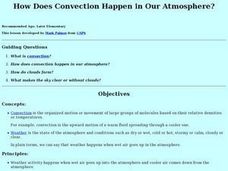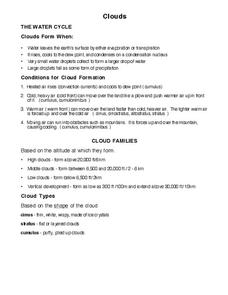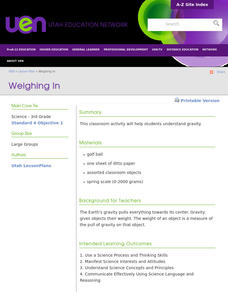Curated OER
Harvest the Wind
Wind is a natural resource available around the world. Help your pupils appreciate the power and importance of wind by researching wind farms, making pinwheels, and designing windmills.
Curated OER
Writing the Wind
Learners make a windmill. In this wind lesson plan, students learn background information about the windmill, complete an activity where they create a windmill, discuss using wind as a natural resource and brainstorm other inventions...
Curated OER
"Blow, Wind, Blow" - Wind Power
In this renewable energy instructional activity, students learn about wind power. They then answer the 2 questions on the instructional activity. The answers are on the last page of the packet.
Curated OER
States of Matter
Students discover states of matter. In this science lesson plan, students define matter, identify states of matter, explain properties of matter, and demonstrate the various uses of the states of matter.
Curated OER
Celebrating A Century of Flight
Students investigate the Wright Brothers. They complete an online Webquest, explore various websites, use a flight simulator, answer discussion questions, and locate newspaper articles on the 100th anniversary of the Wright brothers'...
Curated OER
On the Wright Brothers' Flight Path
In this airplane worksheet, students complete a graphic organizer by comparing three Wright brothers' airplanes: how were they alike and how were they different.
Curated OER
Let's Pretend
In this Language Arts worksheet, learners read a poem called "Let's Pretend." The poem includes descriptions of different animals, such as a bird and a horse.
Curated OER
Immersion Presents Monterey Bay
Students study Monterey Bay. In this Monterey Bay lesson, students create a model of upwelling around Monterey Bay. Students simulate surface water movement relative to prevailing winds.
Curated OER
History of the Current
Students, in groups, collect information from the Internet about historical events surrounding the effects of the Gulf Stream current on ship travel. They compile a chart and answer assessment questions.
Curated OER
Learning Lesson: Measure the Pressure -- The "Wet" Barometer
Students use simple objects to create their own barometer. They have five days to build it and ten days to observe and collect data. They examine thunderstorm safety tips to end the lesson.
Curated OER
How Does Convection Happen in Our Atmosphere?
Young scholars explore convection and how it happens in the earth's atmosphere.
Curated OER
Clouds
In this science worksheet, students look for the meaning of the water cycle and its relation to the formation of clouds. They read the information about the different types of clouds.
Curated OER
Activity #8 Simulation of Oil Spills
Students conduct an experiment to simulate an oil spill and identify the characteristics of oil in water. They evaluate the effectiveness of various cleanup methods. They discuss the how to clean up an oil spill, and what causes oil...
Curated OER
Salinity
Learners define and discuss salinity, conduct classroom experiment to determine salinity of water sample by using hydrometer, record predictions, and demonstrate understanding of how salinity influences object's ability to float in water.
Curated OER
Buoyancy: What will float and what will sink
Students write and explain why an object sinks or floats. In this buoyancy lesson students demonstrate how items float or sink and graph the results.

















